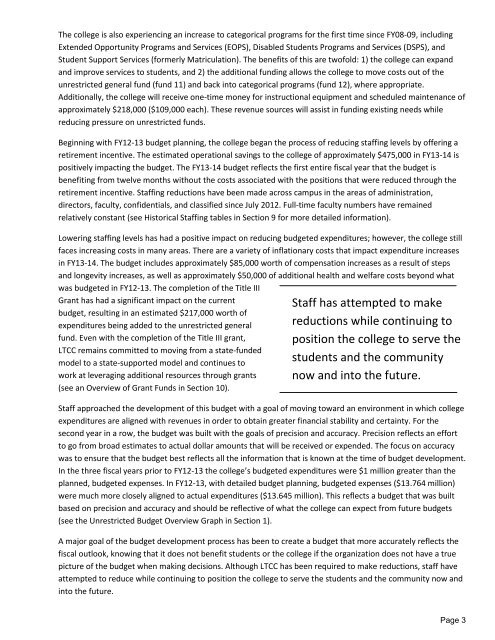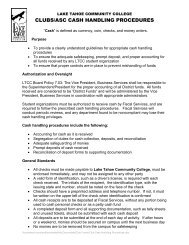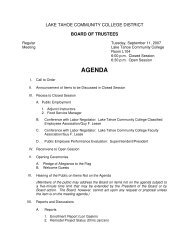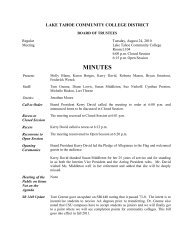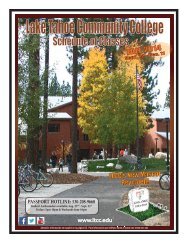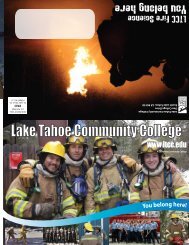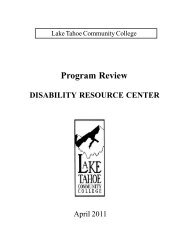Fiscal Year 2013-14 - Lake Tahoe Community College
Fiscal Year 2013-14 - Lake Tahoe Community College
Fiscal Year 2013-14 - Lake Tahoe Community College
- No tags were found...
You also want an ePaper? Increase the reach of your titles
YUMPU automatically turns print PDFs into web optimized ePapers that Google loves.
The college is also experiencing an increase to categorical programs for the first time since FY08-09, including<br />
Extended Opportunity Programs and Services (EOPS), Disabled Students Programs and Services (DSPS), and<br />
Student Support Services (formerly Matriculation). The benefits of this are twofold: 1) the college can expand<br />
and improve services to students, and 2) the additional funding allows the college to move costs out of the<br />
unrestricted general fund (fund 11) and back into categorical programs (fund 12), where appropriate.<br />
Additionally, the college will receive one-time money for instructional equipment and scheduled maintenance of<br />
approximately $218,000 ($109,000 each). These revenue sources will assist in funding existing needs while<br />
reducing pressure on unrestricted funds.<br />
Beginning with FY12-13 budget planning, the college began the process of reducing staffing levels by offering a<br />
retirement incentive. The estimated operational savings to the college of approximately $475,000 in FY13-<strong>14</strong> is<br />
positively impacting the budget. The FY13-<strong>14</strong> budget reflects the first entire fiscal year that the budget is<br />
benefiting from twelve months without the costs associated with the positions that were reduced through the<br />
retirement incentive. Staffing reductions have been made across campus in the areas of administration,<br />
directors, faculty, confidentials, and classified since July 2012. Full-time faculty numbers have remained<br />
relatively constant (see Historical Staffing tables in Section 9 for more detailed information).<br />
Lowering staffing levels has had a positive impact on reducing budgeted expenditures; however, the college still<br />
faces increasing costs in many areas. There are a variety of inflationary costs that impact expenditure increases<br />
in FY13-<strong>14</strong>. The budget includes approximately $85,000 worth of compensation increases as a result of steps<br />
and longevity increases, as well as approximately $50,000 of additional health and welfare costs beyond what<br />
was budgeted in FY12-13. The completion of the Title III<br />
Grant has had a significant impact on the current<br />
budget, resulting in an estimated $217,000 worth of<br />
expenditures being added to the unrestricted general<br />
fund. Even with the completion of the Title III grant,<br />
LTCC remains committed to moving from a state-funded<br />
model to a state-supported model and continues to<br />
work at leveraging additional resources through grants<br />
(see an Overview of Grant Funds in Section 10).<br />
Staff has attempted to make<br />
reductions while continuing to<br />
position the college to serve the<br />
students and the community<br />
now and into the future.<br />
Staff approached the development of this budget with a goal of moving toward an environment in which college<br />
expenditures are aligned with revenues in order to obtain greater financial stability and certainty. For the<br />
second year in a row, the budget was built with the goals of precision and accuracy. Precision reflects an effort<br />
to go from broad estimates to actual dollar amounts that will be received or expended. The focus on accuracy<br />
was to ensure that the budget best reflects all the information that is known at the time of budget development.<br />
In the three fiscal years prior to FY12-13 the college’s budgeted expenditures were $1 million greater than the<br />
planned, budgeted expenses. In FY12-13, with detailed budget planning, budgeted expenses ($13.764 million)<br />
were much more closely aligned to actual expenditures ($13.645 million). This reflects a budget that was built<br />
based on precision and accuracy and should be reflective of what the college can expect from future budgets<br />
(see the Unrestricted Budget Overview Graph in Section 1).<br />
A major goal of the budget development process has been to create a budget that more accurately reflects the<br />
fiscal outlook, knowing that it does not benefit students or the college if the organization does not have a true<br />
picture of the budget when making decisions. Although LTCC has been required to make reductions, staff have<br />
attempted to reduce while continuing to position the college to serve the students and the community now and<br />
into the future.<br />
Page 3


